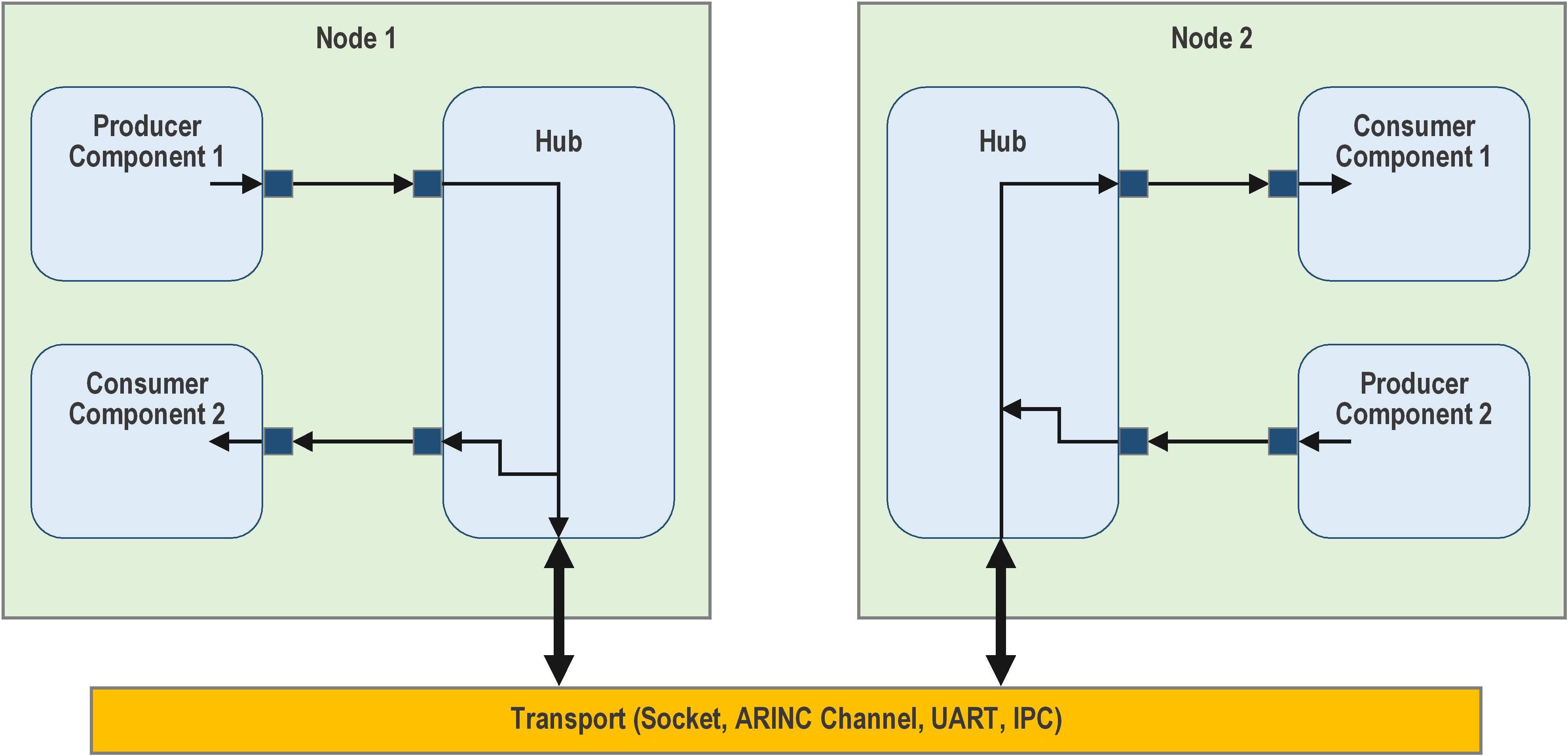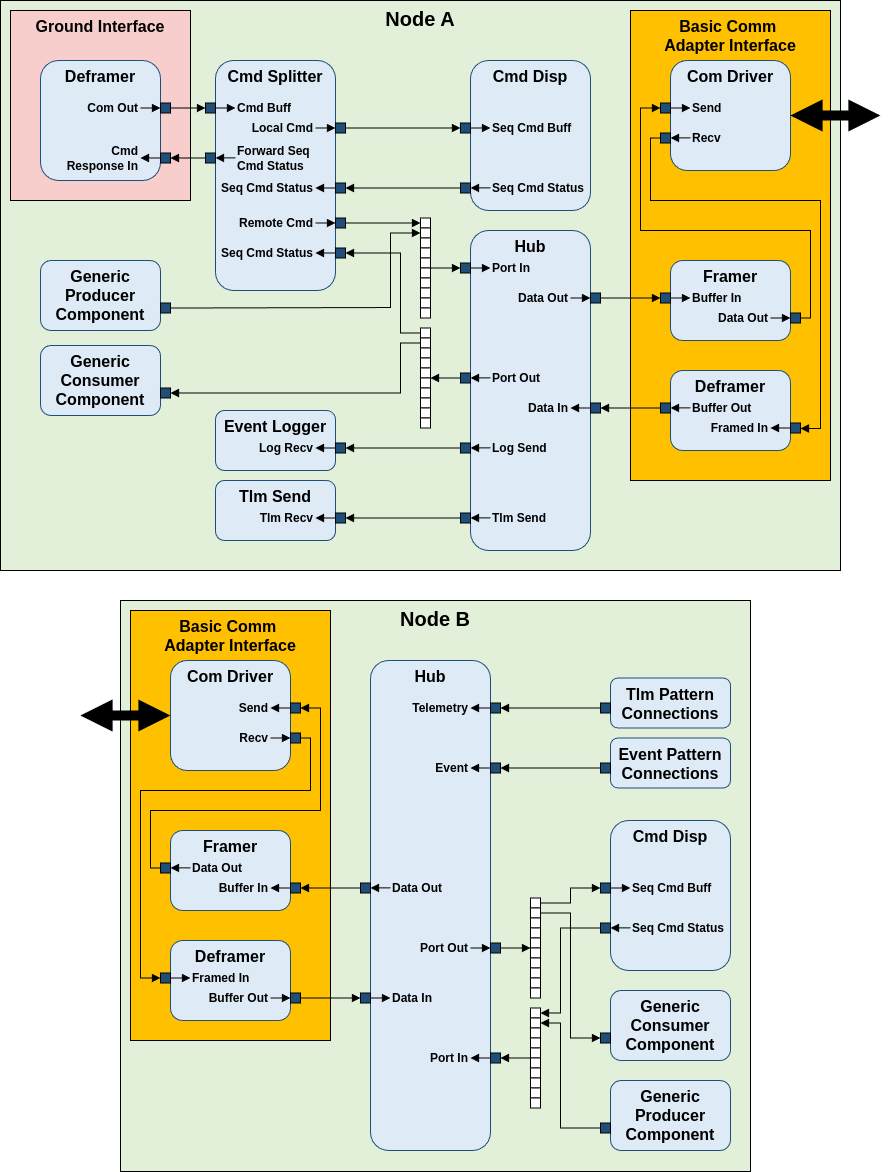A Quick Look at the Hub Pattern
The Hub pattern is a way to distribute F´ applications across some barriers. These barriers may be address-space barriers, platform barriers, or other divides. With the hub pattern, we connect F´ ports through a serialized comm link and then out the interface on the other side of the barrier. It is built around the hub.
A hub is a component with multiple serialization input and output ports. Typed ports from a calling component are connected to the Hub’s serialization ports. These ports allow any inputs which serialize to the communication bridge across the divide. On the other side of the divide, the Hub unwraps the calls back into the typed ports. In this way, typed ports are connected to typed ports using the Hub as an intermediary to get across the divide.

Figure 9. Hub pattern. Each hub instance is responsible for connecting to a remote node. Input port calls are repeated to corresponding output ports on a remote hub. These hubs have been demonstrated on Sockets, ARINC 653 Channels, High-speed hardware buses between nodes, and UARTs between nodes in an embedded system.
Generic Hub
There is now a standard implementation of the hub pattern. The
GenericHub is an implementation of the hub pattern
that passes through F´ ports and Fw::Buffers.
Example Hub Pattern Project
A sample F´ project featuring a two-deployment hub setup can be found on fprime-community.
Hub Pattern Implementation Breakdown
A possible usage of the Hub pattern includes running F´ on multiple computers acting as one F´ system. This example could serve as a base for a multi-computer system running F´.

In this example, a basic implementation of the
Communication Adapter Interface facilitates the
transfer of serialized data between the two nodes across two different deployments. While they are
excluded from this example for simplicity, a Fw::ComStub and Fw::ComQueue components could be
added to make this communication link between hubs more robust. The Hub uses the Data Out port to
export serialized data to the remote hub, which receives them on the Data In port. This connection
works reflexively, allowing the two hubs to communicate and transmit data between each other.
A Command Splitter sits between the Ground Interface and a local Command Dispatcher and splits command opcodes to either a local or remote command dispatcher. The command opcode offset of the command splitter should match the commands on the external node. An offset of 0x10000 will route any command received above the offset directly to the hub, while commands below the offset will be routed to the local Command Dispatcher.Instance ids must also match this offset, which may be implemented as the following for each instance in instances.fpp:
# In Node B's instances.fpp
module Node_B_Deployment {
constant CMD_SPLITTER_OFFSET = 0x10000
...
instance b_hub: Svc.GenericHub base id CMD_SPLITTER_OFFSET + 0x9000
...
}
Configure the Command Splitter by calling
cmdSplitter.configure(0x10000);in Node A’s topology.cpp
Port In and Port Out are arrays of serial ports that should be parallel to each other across
hubs. A connection to Hub A’s Port In index 0 will be routed to Hub B’s Port Out index 0. In
this example, the Command Splitter in Node A is connected to the Command Dispatcher in Node B
through the hub port arrays. Data flow from Node B to A work in the same way, such that Hub B’s
Port In will be parallel to Hub A’s Port Out.
To receive telemetry from Node B through the Ground Interface from Node A, Telemetry and Event
Connections can be defined through the pattern graph specifiers. The hub replaces
Svc::ActiveLogger and Svc::TlmChan in the pattern graph specifiers of Node B, which would
reroute all events and logs to the hub and to the ActiveLogger and TlmChan of Node A. Events and
Telemetry have a dedicated Port In the hub, which are connected to Node A’s Event Logger and Tlm
Send through the Log Send and Tlm Send port of the hub.
# In Node B's topology.fpp
...
# event connections instance b_eventLogger
event connections instance b_hub
# telemetry connections instance b_tlmSend
telemetry connections instance b_hub
...
# In Node A's topology.fpp
...
connections hub {
a_hub.LogSend -> a_eventLogger.LogRecv
a_hub.TlmSend -> a_tlmSend.TlmRecv
}
...
Implementation Notes
All instances names should be unique across the entire F´ System. Telemetry channels and events are named based on their respective component instance name, and re-using the same instance name between multiple deployments may result in naming conflicts.
Creating a Combined Dictionary for a Multi-deployment System
Since this system is running on two deployments, the command, telemetry, and event dictionaries need
to be merged together so the GDS can process data received from both deployments. Running
fprime-gds using a dictionary from build-artifacts of one deployment but not both would drop
telemetry and logging from the other deployment, and GDS will not display any inner-deployment
commands. Using FPP Tools,
we can generate a list of dependencies for topologies of both deployments and create a combined
dictionary.
Create a new directory structure on the same level as the two other deployments. Additionally, create a new topology.fpp file and a shell script file within the directory. The directory structure should look like this:
FPrimeProject
├── build
├── build-artifacts
├── ...
├── Node_A_Deployment
├── Node_B_Deployment
└── GDSDictionary
├── generate_dictionary.sh
└── topology.fp
In the new topology.fpp file, import the topologies from the two deployments like this:
# In GDSDictionary/Topology.fpp
topology GDSDictionary {
import NodeA.NodeA
import NodeB.NodeB
}
Using FPP-Tools, we can manually generate a ground dictionary by finding the dependencies of
GDSDictionary, which includes the dependencies of Node A and Node B.
fpp-depend writes out the names of generated files during dependency analysis. This uses the
locs.fpp file generated when running fprime-util generate and retrieves the files needed to build
the dictionaries for both Node A and Node B. fpp-to-dict uses these dependencies and builds a
dictionary. These can be either ran in the terminal or executed with a shell script.
#!/bin/bash
fpp-depend ../build-fprime-automatic-native/locs.fpp topology.fpp -g deps.txt
tr '\n' ',' < deps.txt | sed 's/,$//' > deps-comma.txt
fpp-to-dict -i `cat deps-comma.txt` topology.fpp
See FPP User’s Guide for generating dictionaries using
fpp-to-dict.
